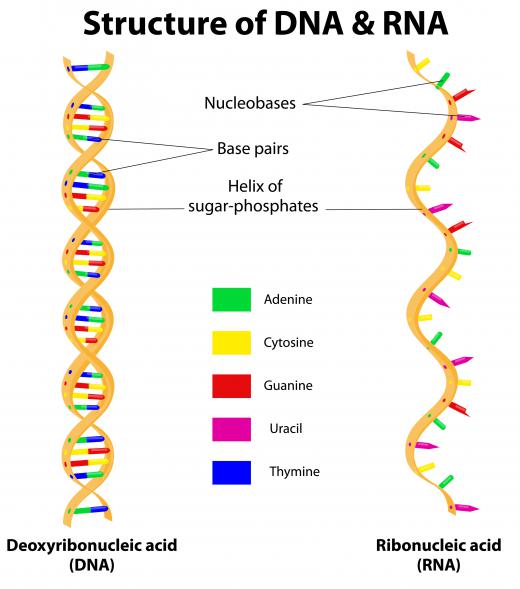What are Polymers?
 Michael Anissimov
Michael Anissimov
Polymers are molecules that consist of a long, repeating chain of smaller units called monomers. They have the highest molecular weight among any molecules, and may consist of billions of atoms. Human DNA is a polymer with over 20 billion constituent atoms. Proteins, made up of amino acids, and many other molecules that make up life are polymers. They are the largest and most diverse class of known molecules and even include plastics.
Monomers are molecules typically about 4-10 atoms in size, and are reactive in that they bond readily to other monomers in a process called polymerization. Polymers and their polymerization processes are so diverse that a variety of different systems exist to classify them. One major type is condensation polymerization, where reacting molecules release water as a byproduct. This is the means by which all proteins are formed.

Polymers are not always straight chains of regular repeating monomers; sometimes, they consist of chains of varying length, or even chains that branch in multiple directions. Residual monomers are often found together with the polymers they create, giving the molecules additional properties. To coax monomers to link together in certain configurations requires a variety of catalysts — secondary molecules that speed up reaction times. Catalysts are the basis of most synthetic polymer production.
In copolymerization, chains are formed that contain two or more different monomers. Larger, more complex polymers tend to have higher melting points and tensile strengths than others, due to the wealth of intermolecular forces acting between their constituents. Certain molecules are so complex that they cannot be readily identified, so techniques such as wide angle x-ray scattering, small angle x-ray scattering, and small angle neutron scattering are employed.
AS FEATURED ON:
AS FEATURED ON:











Discussion Comments
Polymers are used in Human DNA? Weird!
Not enough information about types and formation.
What is the purpose in identifying different polymers and why?
What do polymers have to do with aging?
What are the uses of polymers in packaging and clothing?
how are the polymers in regular petroleum based plastic different from the ones in biodegradable corn plastic?
It's horrible how we're dying. Microwaving for sure plays a role in toxicity. :X
What is the different between polyamide and polyamines?
What are the problems relating to plastics (polymers)?
Just wondering, if melamine and polymers are used to make plastic dishes and storage containers for food...when people put them in the micro-wave and get all of those electrons hopping around...do the organic elements of the melamine and polymers bond with the organic properties in the food we eat and carry along with it nasty intermolecular forces that make their way through our digestive systems and effect the organs that filter out the usuable from the waste? Is this being carried through our bladders, kidneys, liver and colon and digestive tract, and possibly be the cause for cancer that is killing off people and animals that are otherwise healthy? I mean I have seen so much of this in young people and this may shock you, but when I was a kid dogs and cats died of old age and maybe getting hit by cars. Now every neighbor I have their animals are dying of cancer and living almost half of the lifespan they used to live. Older people who don't use micro-waves to heat up food or plastic containers - are they living longer while people in their thirties are dropping like flies because of this?
Post your comments